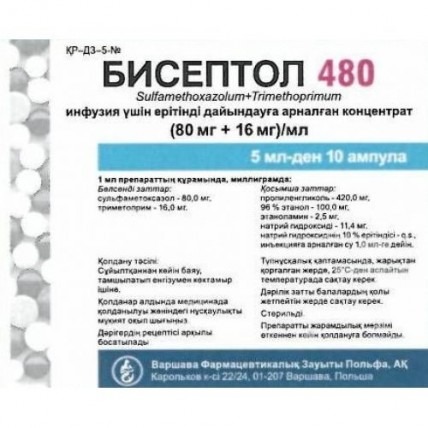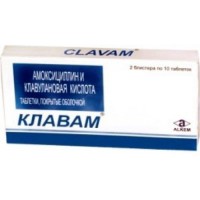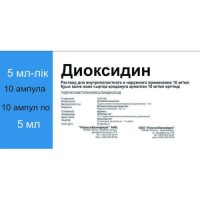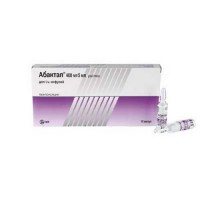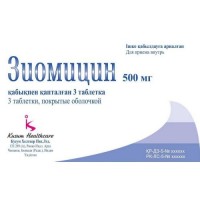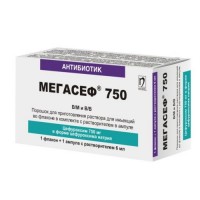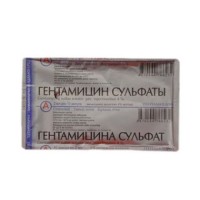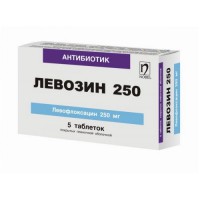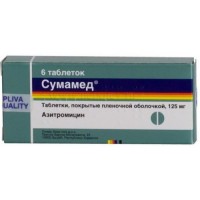Biseptolum 480 mg / 5 ml 10s solution for injection in ampoules
- $29.70
The instruction for medical use
of medicine
Biseptolum 480
the Trade
name Biseptolum 480 International Unlicensed Name
Is not present
the Dosage form
the Concentrate for preparation of solution for infusions (80 mg + 16 mg) / ml
Structure
of 1 ml of a concentrate contains
active agents: sulfamethoxazole of 80.00 mg, Trimethoprimum of 16.00 mg
excipients: propylene glycol, ethanol of 96%, sodium hydroxide, ethanolamine, 10% hydroxide sodium solution, water for injections
the Description
Colourless or slightly yellowish color liquid.
Pharmacotherapeutic group
Antibacterial drugs for system use. Streptocides and trimeto uses Streptocides in a combination with Trimethoprimum and its derivatives. Co-trimoxazole.
The ATX J01EE 01 code
the Pharmacological
Pharmacokinetics Maximum Concentration properties of sulfamethoxazole and Trimethoprimum, defined in one hour, is higher and is reached quicker after intravenous administration, in comparison with the concentration received after oral administration. The significant distinctions concerning concentration in plasma, elimination half-life and elimination after administration of co-trimoxazole in an oral and intravenous form are not established.
Trimethoprimum is the weak basis (pKa = 7.3) with lipophilic properties. Concentration of Trimethoprimum in fabrics is higher, than the concentration defined in plasma especially high it in lungs and kidneys. Higher concentrations of Trimethoprimum in comparison with plasma are observed in bile, liquid and fabrics of a prostate, a phlegm, vaginal discharge. Concentration of Trimethoprimum in breast milk, cerebrospinal liquid, secretion of a middle ear, synovial fluid, intracellular liquid (interstitial) correspond to the concentration necessary for antibacterial action. Trimethoprimum gets into amniotic waters and fabrics of a fruit, reaching the concentration close to the concentration observed in uterus serum there.
About 50% of Trimethoprimum contact proteins of plasma. Elimination half-life at persons with normal function of kidneys makes from 10 to 12 hours. Significant distinctions at elderly people in comparison with young patients are noted.
Trimethoprimum is removed generally by kidneys - about 50% in not changed view within 24 hours with urine. In urine several metabolites of Trimethoprimum are identified.
Sulfamethoxazole is weak acid with pKa = 6.0. Concentration of an active form of sulfamethoxazole in amniotic liquid, bile, cerebrospinal liquid, secretion of a middle ear, a phlegm, synovial fluid, intracellular liquid makes from 20% to 50% of the sulfamethoxazole which is in plasma.
About 66% of sulfamethoxazole contact proteins of plasma. Elimination half-life at persons with normal function of kidneys makes from 9 to 11 hours. At persons with a renal failure of changes of size of elimination half-life of an active form of sulfamethoxazole it is not established, but lengthening of elimination half-life of the main acetylized metabolite is observed if the clearance of creatinine is less than 25 ml/minute.
Sulfamethoxazole is removed, first of all, by kidneys, from 15% to 30% of the entered dose it is found in urine in an active form. At patients
of advanced age the decrease in renal clearance of sulfamethoxazole is observed.
The pharmacodynamics
Biseptolum 480 is the combined antibacterial agent containing co-trimoxazole – mix in a proportion of 5:1 sulfamethoxazole and Trimethoprimum.
Sulfamethoxazole breaks synthesis of dihydrofolic acid in bacterial cells interfering with inclusion of para-aminobenzoic acid in its molecule. It is bacteriostatic action.
Trimethoprimum strengthens effect of sulfamethoxazole, breaking restoration of dihydrofolic acid in tetragidrofoliyevuyu-the active form of folic acid responsible for protein metabolism and division of a microbic cell. Depending on conditions, it can have bactericidal or bacteriostatic effect. Thus, Trimethoprimum and sulfamethoxazole block two consecutive stages of biosynthesis of purines, and then the nucleic acids necessary for many bacteria.
Is bactericidal drug of a broad spectrum of activity, it is active concerning the following microorganisms: gram-positive - S. aureus, S. pneumoniae, S. pyogenes, E. faecalis, C. diphtheriae, L. monocytogenes gram-negative - E. coli, Klebsiella spp., P. mirabilis, Serrratia marcescens, Salmonella spp., Shigella spp., H. influenzae, A. gonorrhoeae, N. meningitidis, P. aeruginosa, S. maltophilia, others - Nocardia asteroides.
Indications
- heavy uncomplicated infections of urinary tract
- treatment and prevention of the pneumonia caused by Pneumocystis jiroveci (before Pneumocystis carinii) (PCP)
- treatment and prevention of toxoplasmosis.
The route of administration and doses
Biseptolum 480 should be applied in cases when oral administration of medicine is impossible (or it is not recommended) or, according to the doctor, it is necessary to apply the medicine containing two antibacterial active agents.
Biseptolum 480, a concentrate for preparation of solution for infusions, is intended only for intravenous administration, and it should be parted just before use.
After administration of the drug Biseptolum 480 in solution for infusions the received mix needs to be stirred up vigorously for the purpose of full mixing. In case of detection of a deposit or emergence of crystals before mixing or during infusion, mix should be destroyed and prepared new.
The following scheme of cultivation
of the drug Biseptolum 480 1 an ampoule (5 ml) of the drug Biseptolum 480 in 125 ml of solution for infusions
2 ampoules (10 ml) of the drug Biseptolum 480 in 250 ml of solution for infusions
3 ampoules (15 ml) of the drug Biseptolum 480 in 500 ml of solution for infusions is recommended
use of the following solutions for infusions for cultivation of the drug Biseptolum of 480 - 5% and 10% solution of glucose, 0.9% NaCl solution, Ringera solution, 0.45% NaCl solution from 2.5% Is allowed by glucose solution.
The prepared solution for infusions of the drug Biseptolum 480 should not be mixed with other medicines or other than above-mentioned solutions for infusions.
Duration of infusion has to be about 60 - 90 minutes and depend on degree of an irrigation of the patient.
If introduction of a large amount of liquid is contraindicated to the patient, use of higher concentration of co-trimoxazole - 5 ml in 75 ml of 5% of glucose is allowed. The prepared solution should be entered in the form of infusion within no more than one hour.
Unused solution should be poured out.
Acute infections
Adults and children are aged more senior than 12 years:
Usually apply on 2 ampoules (960 mg / 10 ml) each 12 hours.
Children are aged younger than 12 years:
A daily dose of 36 mg/kg of weight in 2 receptions in 12 hours.
The scheme of drug dosing Biseptolum 480, a concentrate for preparation of solution for infusions (80 mg + 16 mg) / ml, before introduction drug it is necessary to dissolve as it is described above.
Age from 3 to 5 years: 2.5 ml / 240мг each 12 hours.
Age from 6 to 12 years: 5 ml / 480 mg each 12 hours.
In case of heavy infections in all age groups of a dose it is possible to increase by 50%.
Treatment should be carried out within at least five days or within two days after disappearance of symptoms of a disease.
Patients with a renal failure
in case of adults and children are more senior than 12 years (data on children are aged younger than 12 years are absent) with a renal failure the drug dosing should be modified depending on clearance of creatinine. At clearance of creatinine higher than 30 ml/min. appoint a usual dose, at 15-30 ml/min. - 1/2 usual doses, at lower than 15 ml/min. - use is not recommended.
Definition of concentration of sulfamethoxazole in serum in the samples taken 12 hours later after administration of the drug Biseptolum 480 is recommended each 2-3 days. If the general concentration of sulfamethoxazole exceeds 150 mkg/ml, treatment it is necessary to stop less than 120 mkg/ml until decrease in concentration.
The pneumonia caused by Pneumocystis jiroveci (before Pneumocystis carinii)
Treatment
at the rate of 100 mg of sulfamethoxazole and 20 mg of Trimethoprimum on body weight kg a day in 2 or more divided doses. As soon as possible the patient has to pass to an oral form of medicine. The course of treatment should not exceed 14 days. The purpose of therapy is achievement of the maximum concentration of Trimethoprimum in plasma or in serum, it is more or equal 5 mkg/ml (defined at the patients receiving drug intravenously by drop infusion within an hour).
Prevention
Toxoplasmosis
For prevention is supposed the same dosing, as for prevention of PCP (the pneumonia caused by Pneumocystis jiroveci).
Side effects
Often
- a hyperpotassemia
- skin rash
- candidiasis
- a headache
- nausea, vomiting, diarrhea
Very seldom
- a leukopenia, a neutropenia, thrombocytopenia, an agranulocytosis, megaloblastny anemia, aplastic anemia, hemolytic anemia, a methemoglobinemia, an eosinophilia, a purpura, hemolysis at hyper sensitive patients with deficit glyukozo-6-fosfatdegidrogenazy (the treatments which are usually taking place after end, however in isolated cases they can turn into serious condition, especially it concerns patients at advanced age, with abnormal liver functions or kidneys and also with deficiency of folic acid)
- a serum disease, an anaphylaxis, allergic myocarditis, vasomotorial hypostasis, medicamentous fever, the allergic vasculitis reminding Shenleyn's disease - Genokh, a nodular periarteritis, a system lupus erythematosus
- pulmonary infiltrates: eosinophilic infiltrate, an allergic alveolitis
- a hypoglycemia, a hyponatremia, anorexia
- a depression, hallucinations
- the aseptic meningitis (passing after
medicine cancellation), spasms, neuritis, an ataxy, dizzinesses, sonitus
- cough, shallow breathing, infiltrate in lungs
- stomatitis, a pseudomembranous coloenteritis
- a glossitis, pancreatitis
- increase in level of aminotransferases in serum, increase in level of bilirubin, cholestatic jaundice, liver necrosis
- a photosensitization, exfoliative dermatitis, persistent medicamentous rash, a polymorphic erythema, Stephens-Johnson's syndrome, an epidermal toxic necrolysis (Lyell's disease)
- arthralgias, myalgias
- renal failures, interstitial nephrite
of the Contraindication
- hypersensitivity to streptocides, Trimethoprimum, to -
to a trimoksazol or any auxiliary component of drug
- serious damage of a parenchyma of a liver
- a blood disease (aplastic anemia, B12-scarce anemia, an agranulocytosis, a leukopenia)
- it is not necessary to use drug at patients with heavy hematologic
disturbances
- a liver failure
- a heavy renal failure
- children's age up to 3 years (except for treatment or prevention
of the pneumonia caused by Pneumocystis jiroveci)
- deficit glyukozo-6 fosfatdegidrogenaza
- pregnancy and the period of a lactation
- a hyperbilirubinemia at children
Medicinal interactions
It is necessary to inform the doctor on all drugs used recently as prescription and without prescription.
At patients of advanced age, use of Biseptolum 480 along with some diuretics, especially tiazidam, increases risk of decrease in quantity of thrombocytes. At patients, treated co-trimoxazole and preventively accepting Pyrimethaminum (antimalarial means) in doses of 25 mg a week, noted cases of development of megaloblastny anemia. Use of combination therapy of this kind is not recommended. Biseptolum 480 can exponentiate effect of the anticoagulants, Phenytoinum, hypoglycemic medicines derivative of sulphonylurea and a message to increase in concentration of digoxin in blood serum.
At patients, treated co-trimoxazole and cyclosporine (for example, after transplantation of kidneys) observed tranzitorny deterioration in function of kidneys.
At simultaneous use of a methotrexate and co-trimoxazole it is necessary to apply salts of folic acid.
Diuretics (tiazida and at elderly patients are more often) increase risk of developing megaloblastny anemia.
At simultaneous use with indometacin the increase in concentration of sulfamethoxazole in blood is possible.
The medicines oppressing a marrowy hemopoiesis increase risk of myelosuppression.
Biseptolum 480 can reduce efficiency of tricyclic antidepressants.
Biseptolum 480 can also influence procaineamide, amantadin and rifampicin. At simultaneous use of co-trimoxazole and rifampicin within a week there is a reduction of elimination half-life of Trimethoprimum. It has, however, no great clinical value. At simultaneous use of co-trimoxazole and procaineamide or an amantadin there can occur increase in concentration in blood serum of the listed medicines.
At simultaneous use of co-trimoxazole and a zidovudine the risk of development of hematologic disturbances and therefore it is necessary to conduct blood tests increases.
Drug contains ethanol and therefore simultaneous introduction with metronidazole can cause a syndrome of intolerance of alcohol.
It is only necessary to appoint the special instructions Biseptolum when advantages exceed risk.
It is necessary to be careful when prescribing Biseptolum to 480 patients with deficiency of folic acid (for example, to the faces dependent on alcohol, receiving treatment by anticonvulsants, with a sprue and to elderly people), to patients with asthma and a severe form of an allergy, to patients with diseases of the blood circulatory system and a respiratory system, a disease of a thyroid gland because after introduction of high doses, there can occur excessive hydration. During use of drug it is necessary to support an appropriate diuresis. At the exhausted patients the risk of emergence of crystals of streptocides in urine increases.
At therapy course duration more than 5 days and/or increase in a dose of drug it is necessary to control a pattern of peripheral blood, at emergence of pathological changes it is necessary to appoint folic acid in a dose of 5-10 mg/days or folinat calcium. At considerable decrease in number of any blood cells Biseptolum 480 should be cancelled. Patients with a serious hematologic illness can appoint Biseptolum 480 only as an exception.
It is recommended to carry out monitoring of potassium concentration in serum, considering emergence of risk of increase in its concentration (hyperpotassemia).
During intake of Biseptolum 480 (the same as during intake of other antibacterial agents) the pseudomembranous coloenteritis of different degree of manifestation from easy to life-threatening can develop therefore timely diagnosis of this disease at patients who during use of antibacterial medicine had a diarrhea is important.
It is necessary to avoid administration of the drug Biseptolum to 480 patients with the diagnosed porphyria or to patients who have a risk of development of a sharp porphyria because drug can strengthen symptoms of this disease.
It is not necessary to use the drug Biseptolum 480 in treatment of the pharyngitis caused by beta and hemolytic streptococci of group A.
In case of the first symptoms of skin rash it is necessary to stop drug use.
It was reported about development of life-threatening skin reactions: Stephen-Johnson's syndrome and a toxic epidermal necrolysis at use Biseptolum 480.
Patients have to be informed on signs and symptoms and also to look round regularly regarding development of reactions from skin. The highest risk of development of a syndrome of Stephen-Johnson and a toxic epidermal necrolysis is noted within the first weeks of treatment. If symptoms and signs of a syndrome of Stephen-Johnson, a toxic epidermal necrolysis (for example the progressing skin rash, it is frequent with bubbles or erosion of mucous), treatment Biseptolum 480 are revealed it has to be stopped.
The best treatment outcome for a syndrome of Stephen-Johnson and toxic epidermal necrolysis can be reached at early identification and immediate cancellation of any drug causing suspicions.
If at the patient Stephen-Johnson's syndrome or a toxic epidermal necrolysis against the background of use of the drug Biseptolum 480 developed, never this patient can appoint it repeatedly.
Use of the drug Biseptolum 480 for patients with a renal failure.
It is necessary to be careful during use of medicine for patsent with a renal failure.
Use of the drug Biseptolum 480 for patients of old age
For patients of advanced age increases risk of heavy side effects of Biseptolum 480, including injury of kidneys or a liver. Most often the described heavy side effects of Biseptolum at elderly patients are strong skin reactions, oppression of marrow and also thrombocytopenia with a purpura or without purpura. Joint intake of Biseptolum 480 and diuretic drugs increases risk of a purpura.
Influence on ability of control of vehicles and service of potentially dangerous devices
Influence of Biseptolum 480 on ability of control of vehicles and to service of moving mechanisms is not established.
Overdose
Symptoms: nausea, vomiting, dizzinesses, headache, confusion of consciousness. At a severe form of overdose of Trimethoprimum the marrow depression was noted.
Treatment: at emergence of side effects it is necessary to cancel drug immediately. To appoint gastric lavage, input of the fluid, correction of electrolytic disturbances, introduction in oil of 5-15 mg/days of calcium of the folinat (eliminates effect of Trimethoprimum on marrow). If necessary — a hemodialysis.
A form of release and packing
On 5 ml in ampoules of colourless glass. Over the place of a break of an ampoule there is a point of white or red color and a strip in the form of a ringlet of yellow color.
On 5 ampoules put in blister strip packaging from a film polyvinylchloride.
On the 2nd blister strip packagings together with the approved instruction for medical use in the state and Russian languages place in a pack from cardboard.
To Store storage conditions in original packing, in the place protected from light, at a temperature not above 25 °C. Not to freeze!
To store out of children's reach!
Not to apply a period of storage of 2.5 years after an expiration date.
Prescription status
According to the prescription
the Producer
the Warsaw pharmaceutical plant "Polfa" of the autonomous area,
Poland Karolkov St. 22/24, 01-207 Warsaw, Poland
the Owner of the registration certificate
the Warsaw pharmaceutical plant "Polfa" of the joint-stock company, Poland
the Name and the country of the organization packer
the Warsaw pharmaceutical plant "Polfa" of the joint-stock company, Poland
the Address of the organization accepting in the territory of the Republic of Kazakhstan claims from consumers on quality of products (goods)
of JSC Khimfarm,
Republic of Kazakhstan, Shymkent, Rashidov St., 81 Phone number 7252 (561342)
Fax number 7252 (561342)
to Develop the E-mail address of infomed@santo.kz
of medicine
Biseptolum 480
the Trade
name Biseptolum 480 International Unlicensed Name
Is not present
the Dosage form
the Concentrate for preparation of solution for infusions (80 mg + 16 mg) / ml
Structure
of 1 ml of a concentrate contains
active agents: sulfamethoxazole of 80.00 mg, Trimethoprimum of 16.00 mg
excipients: propylene glycol, ethanol of 96%, sodium hydroxide, ethanolamine, 10% hydroxide sodium solution, water for injections
the Description
Colourless or slightly yellowish color liquid.
Pharmacotherapeutic group
Antibacterial drugs for system use. Streptocides and trimeto uses Streptocides in a combination with Trimethoprimum and its derivatives. Co-trimoxazole.
The ATX J01EE 01 code
the Pharmacological
Pharmacokinetics Maximum Concentration properties of sulfamethoxazole and Trimethoprimum, defined in one hour, is higher and is reached quicker after intravenous administration, in comparison with the concentration received after oral administration. The significant distinctions concerning concentration in plasma, elimination half-life and elimination after administration of co-trimoxazole in an oral and intravenous form are not established.
Trimethoprimum is the weak basis (pKa = 7.3) with lipophilic properties. Concentration of Trimethoprimum in fabrics is higher, than the concentration defined in plasma especially high it in lungs and kidneys. Higher concentrations of Trimethoprimum in comparison with plasma are observed in bile, liquid and fabrics of a prostate, a phlegm, vaginal discharge. Concentration of Trimethoprimum in breast milk, cerebrospinal liquid, secretion of a middle ear, synovial fluid, intracellular liquid (interstitial) correspond to the concentration necessary for antibacterial action. Trimethoprimum gets into amniotic waters and fabrics of a fruit, reaching the concentration close to the concentration observed in uterus serum there.
About 50% of Trimethoprimum contact proteins of plasma. Elimination half-life at persons with normal function of kidneys makes from 10 to 12 hours. Significant distinctions at elderly people in comparison with young patients are noted.
Trimethoprimum is removed generally by kidneys - about 50% in not changed view within 24 hours with urine. In urine several metabolites of Trimethoprimum are identified.
Sulfamethoxazole is weak acid with pKa = 6.0. Concentration of an active form of sulfamethoxazole in amniotic liquid, bile, cerebrospinal liquid, secretion of a middle ear, a phlegm, synovial fluid, intracellular liquid makes from 20% to 50% of the sulfamethoxazole which is in plasma.
About 66% of sulfamethoxazole contact proteins of plasma. Elimination half-life at persons with normal function of kidneys makes from 9 to 11 hours. At persons with a renal failure of changes of size of elimination half-life of an active form of sulfamethoxazole it is not established, but lengthening of elimination half-life of the main acetylized metabolite is observed if the clearance of creatinine is less than 25 ml/minute.
Sulfamethoxazole is removed, first of all, by kidneys, from 15% to 30% of the entered dose it is found in urine in an active form. At patients
of advanced age the decrease in renal clearance of sulfamethoxazole is observed.
The pharmacodynamics
Biseptolum 480 is the combined antibacterial agent containing co-trimoxazole – mix in a proportion of 5:1 sulfamethoxazole and Trimethoprimum.
Sulfamethoxazole breaks synthesis of dihydrofolic acid in bacterial cells interfering with inclusion of para-aminobenzoic acid in its molecule. It is bacteriostatic action.
Trimethoprimum strengthens effect of sulfamethoxazole, breaking restoration of dihydrofolic acid in tetragidrofoliyevuyu-the active form of folic acid responsible for protein metabolism and division of a microbic cell. Depending on conditions, it can have bactericidal or bacteriostatic effect. Thus, Trimethoprimum and sulfamethoxazole block two consecutive stages of biosynthesis of purines, and then the nucleic acids necessary for many bacteria.
Is bactericidal drug of a broad spectrum of activity, it is active concerning the following microorganisms: gram-positive - S. aureus, S. pneumoniae, S. pyogenes, E. faecalis, C. diphtheriae, L. monocytogenes gram-negative - E. coli, Klebsiella spp., P. mirabilis, Serrratia marcescens, Salmonella spp., Shigella spp., H. influenzae, A. gonorrhoeae, N. meningitidis, P. aeruginosa, S. maltophilia, others - Nocardia asteroides.
Indications
- heavy uncomplicated infections of urinary tract
- treatment and prevention of the pneumonia caused by Pneumocystis jiroveci (before Pneumocystis carinii) (PCP)
- treatment and prevention of toxoplasmosis.
The route of administration and doses
Biseptolum 480 should be applied in cases when oral administration of medicine is impossible (or it is not recommended) or, according to the doctor, it is necessary to apply the medicine containing two antibacterial active agents.
Biseptolum 480, a concentrate for preparation of solution for infusions, is intended only for intravenous administration, and it should be parted just before use.
After administration of the drug Biseptolum 480 in solution for infusions the received mix needs to be stirred up vigorously for the purpose of full mixing. In case of detection of a deposit or emergence of crystals before mixing or during infusion, mix should be destroyed and prepared new.
The following scheme of cultivation
of the drug Biseptolum 480 1 an ampoule (5 ml) of the drug Biseptolum 480 in 125 ml of solution for infusions
2 ampoules (10 ml) of the drug Biseptolum 480 in 250 ml of solution for infusions
3 ampoules (15 ml) of the drug Biseptolum 480 in 500 ml of solution for infusions is recommended
use of the following solutions for infusions for cultivation of the drug Biseptolum of 480 - 5% and 10% solution of glucose, 0.9% NaCl solution, Ringera solution, 0.45% NaCl solution from 2.5% Is allowed by glucose solution.
The prepared solution for infusions of the drug Biseptolum 480 should not be mixed with other medicines or other than above-mentioned solutions for infusions.
Duration of infusion has to be about 60 - 90 minutes and depend on degree of an irrigation of the patient.
If introduction of a large amount of liquid is contraindicated to the patient, use of higher concentration of co-trimoxazole - 5 ml in 75 ml of 5% of glucose is allowed. The prepared solution should be entered in the form of infusion within no more than one hour.
Unused solution should be poured out.
Acute infections
Adults and children are aged more senior than 12 years:
Usually apply on 2 ampoules (960 mg / 10 ml) each 12 hours.
Children are aged younger than 12 years:
A daily dose of 36 mg/kg of weight in 2 receptions in 12 hours.
The scheme of drug dosing Biseptolum 480, a concentrate for preparation of solution for infusions (80 mg + 16 mg) / ml, before introduction drug it is necessary to dissolve as it is described above.
Age from 3 to 5 years: 2.5 ml / 240мг each 12 hours.
Age from 6 to 12 years: 5 ml / 480 mg each 12 hours.
In case of heavy infections in all age groups of a dose it is possible to increase by 50%.
Treatment should be carried out within at least five days or within two days after disappearance of symptoms of a disease.
Patients with a renal failure
in case of adults and children are more senior than 12 years (data on children are aged younger than 12 years are absent) with a renal failure the drug dosing should be modified depending on clearance of creatinine. At clearance of creatinine higher than 30 ml/min. appoint a usual dose, at 15-30 ml/min. - 1/2 usual doses, at lower than 15 ml/min. - use is not recommended.
Definition of concentration of sulfamethoxazole in serum in the samples taken 12 hours later after administration of the drug Biseptolum 480 is recommended each 2-3 days. If the general concentration of sulfamethoxazole exceeds 150 mkg/ml, treatment it is necessary to stop less than 120 mkg/ml until decrease in concentration.
The pneumonia caused by Pneumocystis jiroveci (before Pneumocystis carinii)
Treatment
at the rate of 100 mg of sulfamethoxazole and 20 mg of Trimethoprimum on body weight kg a day in 2 or more divided doses. As soon as possible the patient has to pass to an oral form of medicine. The course of treatment should not exceed 14 days. The purpose of therapy is achievement of the maximum concentration of Trimethoprimum in plasma or in serum, it is more or equal 5 mkg/ml (defined at the patients receiving drug intravenously by drop infusion within an hour).
Prevention
Toxoplasmosis
For prevention is supposed the same dosing, as for prevention of PCP (the pneumonia caused by Pneumocystis jiroveci).
Side effects
Often
- a hyperpotassemia
- skin rash
- candidiasis
- a headache
- nausea, vomiting, diarrhea
Very seldom
- a leukopenia, a neutropenia, thrombocytopenia, an agranulocytosis, megaloblastny anemia, aplastic anemia, hemolytic anemia, a methemoglobinemia, an eosinophilia, a purpura, hemolysis at hyper sensitive patients with deficit glyukozo-6-fosfatdegidrogenazy (the treatments which are usually taking place after end, however in isolated cases they can turn into serious condition, especially it concerns patients at advanced age, with abnormal liver functions or kidneys and also with deficiency of folic acid)
- a serum disease, an anaphylaxis, allergic myocarditis, vasomotorial hypostasis, medicamentous fever, the allergic vasculitis reminding Shenleyn's disease - Genokh, a nodular periarteritis, a system lupus erythematosus
- pulmonary infiltrates: eosinophilic infiltrate, an allergic alveolitis
- a hypoglycemia, a hyponatremia, anorexia
- a depression, hallucinations
- the aseptic meningitis (passing after
medicine cancellation), spasms, neuritis, an ataxy, dizzinesses, sonitus
- cough, shallow breathing, infiltrate in lungs
- stomatitis, a pseudomembranous coloenteritis
- a glossitis, pancreatitis
- increase in level of aminotransferases in serum, increase in level of bilirubin, cholestatic jaundice, liver necrosis
- a photosensitization, exfoliative dermatitis, persistent medicamentous rash, a polymorphic erythema, Stephens-Johnson's syndrome, an epidermal toxic necrolysis (Lyell's disease)
- arthralgias, myalgias
- renal failures, interstitial nephrite
of the Contraindication
- hypersensitivity to streptocides, Trimethoprimum, to -
to a trimoksazol or any auxiliary component of drug
- serious damage of a parenchyma of a liver
- a blood disease (aplastic anemia, B12-scarce anemia, an agranulocytosis, a leukopenia)
- it is not necessary to use drug at patients with heavy hematologic
disturbances
- a liver failure
- a heavy renal failure
- children's age up to 3 years (except for treatment or prevention
of the pneumonia caused by Pneumocystis jiroveci)
- deficit glyukozo-6 fosfatdegidrogenaza
- pregnancy and the period of a lactation
- a hyperbilirubinemia at children
Medicinal interactions
It is necessary to inform the doctor on all drugs used recently as prescription and without prescription.
At patients of advanced age, use of Biseptolum 480 along with some diuretics, especially tiazidam, increases risk of decrease in quantity of thrombocytes. At patients, treated co-trimoxazole and preventively accepting Pyrimethaminum (antimalarial means) in doses of 25 mg a week, noted cases of development of megaloblastny anemia. Use of combination therapy of this kind is not recommended. Biseptolum 480 can exponentiate effect of the anticoagulants, Phenytoinum, hypoglycemic medicines derivative of sulphonylurea and a message to increase in concentration of digoxin in blood serum.
At patients, treated co-trimoxazole and cyclosporine (for example, after transplantation of kidneys) observed tranzitorny deterioration in function of kidneys.
At simultaneous use of a methotrexate and co-trimoxazole it is necessary to apply salts of folic acid.
Diuretics (tiazida and at elderly patients are more often) increase risk of developing megaloblastny anemia.
At simultaneous use with indometacin the increase in concentration of sulfamethoxazole in blood is possible.
The medicines oppressing a marrowy hemopoiesis increase risk of myelosuppression.
Biseptolum 480 can reduce efficiency of tricyclic antidepressants.
Biseptolum 480 can also influence procaineamide, amantadin and rifampicin. At simultaneous use of co-trimoxazole and rifampicin within a week there is a reduction of elimination half-life of Trimethoprimum. It has, however, no great clinical value. At simultaneous use of co-trimoxazole and procaineamide or an amantadin there can occur increase in concentration in blood serum of the listed medicines.
At simultaneous use of co-trimoxazole and a zidovudine the risk of development of hematologic disturbances and therefore it is necessary to conduct blood tests increases.
Drug contains ethanol and therefore simultaneous introduction with metronidazole can cause a syndrome of intolerance of alcohol.
It is only necessary to appoint the special instructions Biseptolum when advantages exceed risk.
It is necessary to be careful when prescribing Biseptolum to 480 patients with deficiency of folic acid (for example, to the faces dependent on alcohol, receiving treatment by anticonvulsants, with a sprue and to elderly people), to patients with asthma and a severe form of an allergy, to patients with diseases of the blood circulatory system and a respiratory system, a disease of a thyroid gland because after introduction of high doses, there can occur excessive hydration. During use of drug it is necessary to support an appropriate diuresis. At the exhausted patients the risk of emergence of crystals of streptocides in urine increases.
At therapy course duration more than 5 days and/or increase in a dose of drug it is necessary to control a pattern of peripheral blood, at emergence of pathological changes it is necessary to appoint folic acid in a dose of 5-10 mg/days or folinat calcium. At considerable decrease in number of any blood cells Biseptolum 480 should be cancelled. Patients with a serious hematologic illness can appoint Biseptolum 480 only as an exception.
It is recommended to carry out monitoring of potassium concentration in serum, considering emergence of risk of increase in its concentration (hyperpotassemia).
During intake of Biseptolum 480 (the same as during intake of other antibacterial agents) the pseudomembranous coloenteritis of different degree of manifestation from easy to life-threatening can develop therefore timely diagnosis of this disease at patients who during use of antibacterial medicine had a diarrhea is important.
It is necessary to avoid administration of the drug Biseptolum to 480 patients with the diagnosed porphyria or to patients who have a risk of development of a sharp porphyria because drug can strengthen symptoms of this disease.
It is not necessary to use the drug Biseptolum 480 in treatment of the pharyngitis caused by beta and hemolytic streptococci of group A.
In case of the first symptoms of skin rash it is necessary to stop drug use.
It was reported about development of life-threatening skin reactions: Stephen-Johnson's syndrome and a toxic epidermal necrolysis at use Biseptolum 480.
Patients have to be informed on signs and symptoms and also to look round regularly regarding development of reactions from skin. The highest risk of development of a syndrome of Stephen-Johnson and a toxic epidermal necrolysis is noted within the first weeks of treatment. If symptoms and signs of a syndrome of Stephen-Johnson, a toxic epidermal necrolysis (for example the progressing skin rash, it is frequent with bubbles or erosion of mucous), treatment Biseptolum 480 are revealed it has to be stopped.
The best treatment outcome for a syndrome of Stephen-Johnson and toxic epidermal necrolysis can be reached at early identification and immediate cancellation of any drug causing suspicions.
If at the patient Stephen-Johnson's syndrome or a toxic epidermal necrolysis against the background of use of the drug Biseptolum 480 developed, never this patient can appoint it repeatedly.
Use of the drug Biseptolum 480 for patients with a renal failure.
It is necessary to be careful during use of medicine for patsent with a renal failure.
Use of the drug Biseptolum 480 for patients of old age
For patients of advanced age increases risk of heavy side effects of Biseptolum 480, including injury of kidneys or a liver. Most often the described heavy side effects of Biseptolum at elderly patients are strong skin reactions, oppression of marrow and also thrombocytopenia with a purpura or without purpura. Joint intake of Biseptolum 480 and diuretic drugs increases risk of a purpura.
Influence on ability of control of vehicles and service of potentially dangerous devices
Influence of Biseptolum 480 on ability of control of vehicles and to service of moving mechanisms is not established.
Overdose
Symptoms: nausea, vomiting, dizzinesses, headache, confusion of consciousness. At a severe form of overdose of Trimethoprimum the marrow depression was noted.
Treatment: at emergence of side effects it is necessary to cancel drug immediately. To appoint gastric lavage, input of the fluid, correction of electrolytic disturbances, introduction in oil of 5-15 mg/days of calcium of the folinat (eliminates effect of Trimethoprimum on marrow). If necessary — a hemodialysis.
A form of release and packing
On 5 ml in ampoules of colourless glass. Over the place of a break of an ampoule there is a point of white or red color and a strip in the form of a ringlet of yellow color.
On 5 ampoules put in blister strip packaging from a film polyvinylchloride.
On the 2nd blister strip packagings together with the approved instruction for medical use in the state and Russian languages place in a pack from cardboard.
To Store storage conditions in original packing, in the place protected from light, at a temperature not above 25 °C. Not to freeze!
To store out of children's reach!
Not to apply a period of storage of 2.5 years after an expiration date.
Prescription status
According to the prescription
the Producer
the Warsaw pharmaceutical plant "Polfa" of the autonomous area,
Poland Karolkov St. 22/24, 01-207 Warsaw, Poland
the Owner of the registration certificate
the Warsaw pharmaceutical plant "Polfa" of the joint-stock company, Poland
the Name and the country of the organization packer
the Warsaw pharmaceutical plant "Polfa" of the joint-stock company, Poland
the Address of the organization accepting in the territory of the Republic of Kazakhstan claims from consumers on quality of products (goods)
of JSC Khimfarm,
Republic of Kazakhstan, Shymkent, Rashidov St., 81 Phone number 7252 (561342)
Fax number 7252 (561342)
to Develop the E-mail address of infomed@santo.kz
